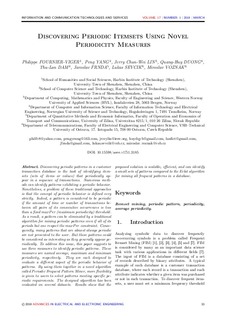| dc.contributor.author | Fournier-Viger, Philippe | |
| dc.contributor.author | Yang, Peng | |
| dc.contributor.author | Lin, Chun Wei | |
| dc.contributor.author | Duong, Quang-Huy | |
| dc.contributor.author | Dam, Thu-Lan | |
| dc.contributor.author | Frnda, Jaroslav | |
| dc.contributor.author | Sevcik, Lukas | |
| dc.contributor.author | Voznak, Miroslav | |
| dc.date.accessioned | 2019-07-01T11:54:14Z | |
| dc.date.available | 2019-07-01T11:54:14Z | |
| dc.date.created | 2019-04-03T21:38:23Z | |
| dc.date.issued | 2019 | |
| dc.identifier.citation | Advances in Electrical and Electronic Engineering. 2019, 17 (1), 33-44. | nb_NO |
| dc.identifier.issn | 1336-1376 | |
| dc.identifier.uri | http://hdl.handle.net/11250/2603036 | |
| dc.description.abstract | Numerous methods can identify patterns exhibiting a periodic behavior. Nonetheless, a problem of these traditional approaches is that the concept of periodic behavior is defined very strictly. Indeed, a pattern is considered to be periodic if the amount of time or number of transactions between all pairs of its consecutive occurrences is less than a fixed maxPer (maximum periodicity) threshold. As a result, a pattern can be eliminated by a traditional algorithm for mining periodic patterns even if all of its periods but one respect the maxPer constraint. Consequently, many patterns that are almost always periodic are not presented to the user. But these patterns could be considered as interesting as they generally appear periodically. To address this issue, this paper suggests to use three measures to identify periodic patterns. These measures are named average, maximum and minimum periodicity, respectively. They are each designed to evaluate a different aspect of the periodic behavior of patterns. By using them together in a novel algorithm called Periodic Frequent Pattern Miner, more flexibility is given to users to select patterns meeting specific periodic requirements. The designed algorithm has been evaluated on several datasets. Results show that the proposed solution is scalable, efficient, and can identify a small sets of patterns compared to the Eclat algorithm for mining all frequent patterns in a database. | nb_NO |
| dc.language.iso | eng | nb_NO |
| dc.publisher | Vysoka Skola Banska * Technicka Univerzita Ostrava | nb_NO |
| dc.rights | Navngivelse 4.0 Internasjonal | * |
| dc.rights.uri | http://creativecommons.org/licenses/by/4.0/deed.no | * |
| dc.title | Discovering Periodic Itemsets using Novel Periodicity Measures | nb_NO |
| dc.type | Journal article | nb_NO |
| dc.type | Peer reviewed | nb_NO |
| dc.description.version | publishedVersion | nb_NO |
| dc.source.pagenumber | 33-44 | nb_NO |
| dc.source.volume | 17 | nb_NO |
| dc.source.journal | Advances in Electrical and Electronic Engineering | nb_NO |
| dc.source.issue | 1 | nb_NO |
| dc.identifier.doi | 10.15598/aeee.v17i1.3185 | |
| dc.identifier.cristin | 1690094 | |
| dc.description.localcode | Copyright © 2019 by the authors. CC-BY license. | nb_NO |
| cristin.unitcode | 194,63,10,0 | |
| cristin.unitname | Institutt for datateknologi og informatikk | |
| cristin.ispublished | true | |
| cristin.fulltext | original | |
| cristin.qualitycode | 1 | |

